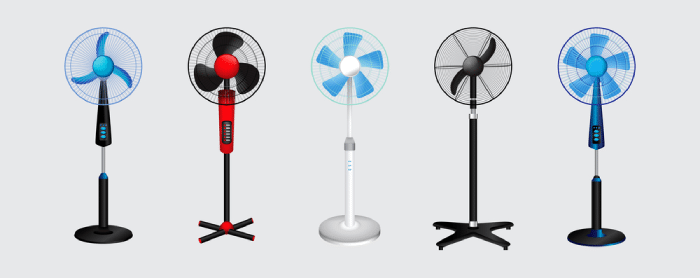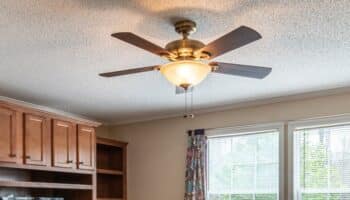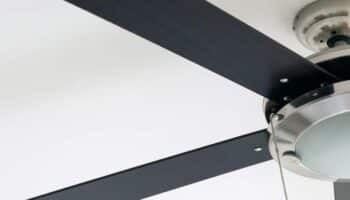Let me guess…
You’ve been sitting looking at your fan, and wondering how much it’s costing you to run that thing all day?
Well, you’re not alone!
I thought the same, and so I’ve spent a good few hours working it out, and even made a calculator.
So, how much does a fan cost to run?
Based on the average US electricity price of $0.13/kWh, a large 100W typically costs just over $0.01/hour to run. So even running a fan for a whole working day would only cost around $0.10. Fans cost much less to run than more complex appliances like air conditioners or refrigerators.
If you want to know exactly how much YOUR fan costs to run, then check out the calculator below! Input what type and size of fan you have, with how much you run it, and you’ll get an estimate about how much it’s going to cost you.
Afterwards I’ve answered some Frequently Asked Questions about fan costs and power ratings – be sure to check it out!
Running Cost Calculator for Fans
The Calculator Explained
Fans have a power rating measured in Watts, which is a multiple of voltage and current. Most fans have a power rating listed on them. But, not all manufacturers provide you with these details.
Once you know your fan wattage, you just need your electricity tariff to find out how much the fan costs to run per hour.
Electricity is charged per kilowatt-hour, which is written as kWh. This reading tells you how much electricity you have consumed over a specified period of time. By multiplying this reading with the tariff, you get the cost of electricity you consume.
The tariff is different for every state but typically ranges between 10 and 40 cents per kWh. Click here to know the electricity cost in your state.
The highest tariff is levied in Hawaii, where residents pay up to 34.5 cents per kWh! The lowest tariff is found in Louisiana and Washington. They are charged 9.6 and 9.7 cents per kWh respectively.
I also included a power setting in the calculator.
This is because running your fan on ‘High’ uses more power than running it on ‘Low’. This is just a rule of thumb, but we can account for this by applying 100%, 70%, or 40% of the rated wattage depending on the power level.
All of that combined gives our cost per hour, which can then be multiplied by days and weeks!
Types of Fans According to Power Rating
We’ve discussed the calculator, as well as the different variables that are applied in this calculation. Let’s also have a look at the different types of fans you can find and their respective average power rating.
Ceiling Fans
These are the most common types of fans and can be found in homes, workplaces, and places with no air conditioning. However, they can also be installed in tandem with ACs, as many people don’t like to keep the AC on all day.

Ceiling fans come in different sizes: small, medium, and large.
Ceiling fans consume the most power as compared to other types of fans. You can find small ceiling fans with a power rating of 55W, whereas large ceiling fans can go as high as 100W.
Their running cost also varies according to their power rating, as we’ve seen above.
Tower Fans
Tower fans refer to fans you see placed in most office buildings. They’re also suitable for outdoor use. They’re highly popular, as they’re much more compact and have no blades.

Rather, they circulate the cool air by rotating their top part. They’re also more energy efficient than other fans.
Typically, a small tower fan will have a power rating of 40W, whereas a medium-sized fan will range from 50W to 70W. Larger fans are rated around 100W, similar to ceiling fans.
Pedestal Fans
Also known as standing fans, pedestal fans are the more portable types of fans. They can be easily carried or placed anywhere. They’re also commonly used because of this very reason.

Most pedestal fans have a louver that keeps spinning to circulate the air in different directions, or their entire body rotates from left to right to cover a larger area.
Pedestal fans have a power rating ranging from 50W to 150W, and this depends on how big or small they are.
Floor/Wall Fans
Simply put, floor/wall fans are fans that come in two configurations. They can be mounted on the wall or placed on the floor with a stand that’s often included in the package.

They take up the least space and are perfect for keeping a restricted space cool and airy. The power rating for this type of fan can vary from 50W to 130W, depending on their size.
Compact/USB Fans
Last but not least, we also have compact fans, and they’re also called table fans. These are the smallest of the lot and are often powered by a USB cable. You can plug these into your computer or a charger that’s plugged into a wall outlet.

Their air throw and ability to keep the room cool is limited, but so is their power rating, which ranges between 2.5W and 10W. They’re sufficient for keeping you cool if you’re sitting close to them.
Do Fans Use a Lot of Electricity?
The amount of electricity consumed by your fan depends on its power rating. It also depends on the duration for which you run it, and the speed you set it on.
A general idea is that fans consume a lot less electricity than air conditioners, which is absolutely true. So, if you’re concerned about rising electricity costs, you can run your air conditioner for a few hours, and then switch to a fan to circulate the cold air.
Let’s have a look at the average energy consumption for different types of fans.
- Ceiling fans consume anywhere between 55W and 100W, depending on their size
- Tower fans consume between 45W and 90W
- Pedestal fans will use anywhere between 45W to 70W normally
Wall fans also have a similar rating. Keep in mind that these power ratings are based on the full speed of a fan. The lower the speed, the less power your fan will consume.
If you compare the aforementioned figures with those of a window AC, you’d find that even the smallest AC has a power rating of 450W, and this figure can go up to 1000W.
Thus, fans are much more energy-efficient and won’t rack up your bill if you run them for a long time.
Let’s also have a look at the energy ratings for central air conditioners.
Their power ratings start from 3000W and can go up depending on their efficiency. Even heaters consume around 1500W to 2000W.
As you can see, your fan’s energy consumption is nothing when you compare it to the larger appliances. Therefore, running your fan is much more energy-efficient and affordable.
How Much Does it Cost to Run a Fan 24/7?
You can use the above calculator to find out how much electricity your fan consumes if you run it round the clock. Let’s look at it in a bit more detail.
Since a fan’s power output is measured in Watts, and you have a general idea of the wattage of each type of fan that’s typically found in homes, you know that if you run a 100W fan for an hour, it consumes 100Wh, or watt-hours, of electricity.
For the purposes of this section, let’s keep the average power rating for a standard fan of any type at 75W.
So, if a fan consumes 75Wh of electricity per hour, it’d consume 75 x 24 = 1800Wh of electricity to run throughout the day.
For a week, this value would be 1800Wh x 7 = 12600Wh. For a month it would be, 1800Wh x 30 = 54000Wh.
Hold on, don’t start freaking out, because this value is in watt-hours, not kilowatt-hours. This is the actual unit for electricity.
Basically, you have to divide 54000 Wh by 1000 to get 54.6 kWh, which looks a lot less scary.
Now, if you multiply this value with the tariff of your state, you’ll get the cost of running your fan 24/7.
Considering that the average cost per kWh in the US is 13.19cents, you’ll get a cost of approximately 720 cents, or $7.2 per month. Pretty cheap, right?
This is more or less the cost of running a central air conditioner for a day! Yes, only one day!
You can tailor this calculation according to the power rating of the fans in your house, which can be anywhere between 30W to 150W. Even if you take the highest value, your energy costs will still be lower than other appliances, which is a massive relief!
Is It Cheaper to Run Fans or Air Conditioners?
As you have seen above, I’ve compared the electricity costs of fans with those of air conditioners, and I’ve based this off the average power ratings for both appliances.
It shows that fans are much more energy-efficient than air conditioners. But, consider this: your central air conditioner cools the entire house, meaning every room is cool.
If you have four rooms, the central air conditioner will cool them down to a certain temperature. Its cost would range from $100 to $200 per month, considering you have an AC with a high power rating.
If you don’t use the AC and turn on a 100W ceiling fan in each room, you’ll be consuming 400 Wh of electricity every hour.
If you run your fans for 24 hours each day, your monthly cost would revolve around $38 to $40.
This cost may go up if you increase the number of fans you run, or if you have fans with a higher power rating.
This shows that it’s much cheaper to run fans than an air conditioner. But also keep in mind that fans only circulate the air inside your room, whereas air conditioners are responsible for cooling the hot air.
Should I Leave a Ceiling Fan on All Day?
If you’re spending the entire day at home, then it makes sense to leave your ceiling fan on all day. Especially because ceiling fans consume more electricity when they start and reach their set speed.
If you run a fan at low speed, it’ll also consume less power.
However, if you plan to leave the fan on all day without using the air conditioner, your room might still heat up due to the temperature outside.
Therefore, a wise thing to do would be to run your air conditioner for at least 2-3 hours and then turn it off, leaving the fan on to circulate the cold air.
Conclusion
People often fuss about how much their electricity bill is rising month by month. They fail to understand which appliances contribute the most to that rising bill.
One thing I can assure you of, fans don’t add up to your electricity consumption as some of the larger appliances do. Besides, they’re helpful for circulating cold air throughout the room, especially if your central air conditioner fails to do so.
I hope this article helps you understand the running costs associated with different types of fans, and how much energy they consume even if you leave them on all the time.
If you liked reading this article, you can also have a look at some of my other articles for more helpful information.
Thank you for reading, and have a cool day!
-Craig







